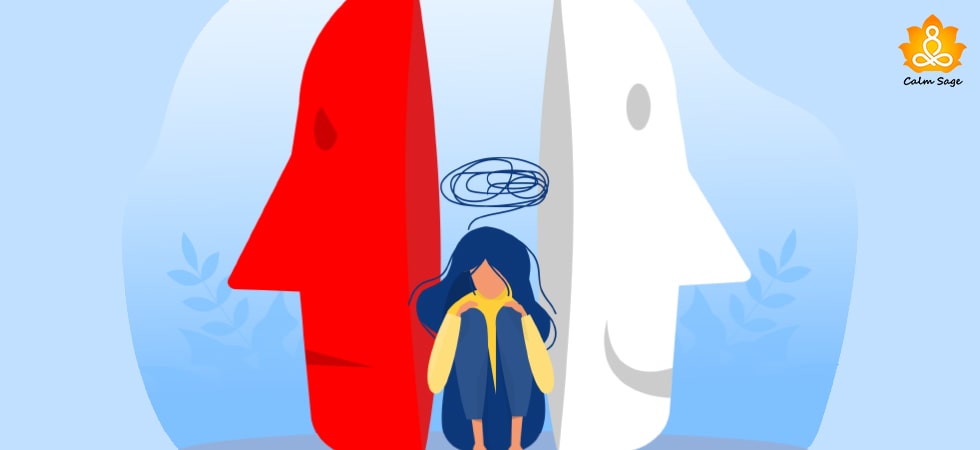Understanding Dysphoric Mania in Bipolar Disorder: Signs, Causes, And More

Living with bipolar disorder can be like riding a roller coaster in real-time. And if you’ve ever ridden the scary ride, then you can imagine the feeling of being on top of the world for one moment, and in the next, crashing into the Earth; well, only figuratively.
That’s what bipolar disorder does to you too. One moment, you’re riding the high, and the next, you’re falling into despair.
Bipolar disorder is known for its unstable mood swings that go between extreme mania (high) and depression (low). Among all types and variants of bipolar disorder, there’s one that is a combination of both mania and depression.
Dysphoric mania is a unique facet of bipolar disorder, wherein you experience the highs and lows of your mood at the same time. Dysphoria, a symptom of depression, can cause you to feel sad and distressed, whereas mania can cause you to feel excited, energetic, and jumpy.
Today, we’re going to understand dysphoric mania in bipolar disorder, its signs, what causes it, and how you can find treatment for dysphoric mania.
Living with bipolar disorder can be like riding a roller coaster in real-time. And if you’ve ever ridden the scary ride, then you can imagine the feeling of being on top of the world for one moment, and in the next, crashing into the Earth; well, only figuratively. That’s what bipolar disorder does to you too. One moment, you’re riding the high, and the next, you’re falling into despair.
Bipolar disorder is known for its unstable mood swings that go between extreme mania (high) and depression (low). Among all types and variants of bipolar disorder, there’s one that is a combination of both mania and depression.
Dysphoric mania is a unique facet of bipolar disorder, wherein you experience the highs and lows of your mood at the same time. Dysphoria, a symptom of depression, can cause you to feel sad and distressed, whereas mania can cause you to feel excited, energetic, and jumpy.
Today, we’re going to understand dysphoric mania in bipolar disorder, its signs, what causes it, and how you can find treatment for dysphoric mania.
Bipolar Disorder At a Glance
Before we learn more about dysphoric mania, let’s take a glance at bipolar disorder. Bipolar disorder, also referred to as manic-depressive disorder, is a mental health condition that can be described as experiencing unusual mood shifts, energy, and activity levels.
If you are diagnosed with bipolar disorder, then you may experience moments of high mood and energy (known as mania) followed by momentary episodes of sadness and despair (known as depression).
When we talk about dysphoric mania, it isn’t a condition on its own, but a feature of bipolar disorder. There is, undoubtedly, a connection between bipolar disorder and dysphoric mania that we’re exploring in this article.
What is Dysphoric Mania in Bipolar Disorder?
When I talk about dysphoric mania, it is a distinct subtype of bipolar disorder where you experience symptoms of depression and mania, at the same time. Imagine having a party in your head where conflicting emotions keep showing uninvited.
This combination of depressive episodes and manic episodes can make your already complicated life more difficult, especially if you’re already struggling with the complex condition of bipolar disorder.
Did you know that almost 40% of people with bipolar disorder also experience dysphoric mania? There are 30% of people who experience euphoric mania. Euphoric mania can mean more than just feeling happy and euphoric. Both dysphoric mania and euphoric mania can cause you to make poor decisions, poor judgment, be impulsive, alongside restlessness.
Dysphoric mania can last for at least one to two weeks and can interfere with your everyday life.
Signs of Dysphoric Mania
Let’s look at the signs and symptoms of dysphoric mania;
1. Depressive Symptoms
- Feelings of sadness
- Lethargy
- A sense of hopelessness
- Weight changes
- Appetite changes
- Slowed movement or speech
- Feelings of guilt
- Feelings of worthlessness
- Poor concentration
- Sleep changes
- Thoughts of suicide
2. Manic Symptoms
- Heightened irritability
- Impulsivity
- Restlessness
- Feeling elated
- Reduced sleep
- Excessive energy
- Loss of appetite
- Rapid movement and speech
- Reckless behavior
- Racing thoughts
- Feelings of grandiose
What Causes Dysphoric Mania?
There are no known causes of dysphoric mania in bipolar disorder, but it is believed that the factors that cause this episode can be a mix of genetics, brain structure, and chemical imbalance.
In a study from 2018, it was found that genetics played a large role in causing dysphoric mood swings in bipolar disorder. Various studies also link circadian dysregulation with dysphoric mania in bipolar.
Not getting enough sleep or getting poor quality sleep can also affect your mood changes. Other factors such as poor diet and a sedentary lifestyle can also cause the symptoms of dysphoric mania.
If you’re prescribed medications such as antidepressants and reuptake inhibitors, then they can also cause manic episodes in bipolar disorder.
Dysphoric Mania Treatment
1. Medications
If you’re not sensitive to certain medications, then mood stabilizers and antipsychotic medications can be prescribed to manage dysphoric mania signs and symptoms. You might need to consult with your doctor or try different combinations of medications or doses to find which one works best. It is important to talk to your doctor before taking any medication.
2. Psychotherapy
Psychotherapy approaches such as cognitive behavioral therapy (CBT), Acceptance and commitment therapy (ACT), or Interpersonal and social rhythm therapy (ISRT) can be used to help you cope with the signs and symptoms of dysphoric mania. Keep in mind that psychotherapy alone might not be enough.
3. Lifestyle Changes
Adopting a simple but stable routine can help you manage your mood swings as well. You can try getting regular exercise, getting enough sleep (good quality sleep), and eating well. Also, learn to manage your stress to lower the risk of extreme mood swings. Lifestyle changes can be a good complementary treatment alongside medication and therapy.
4. Create Support System
Along with the aforementioned practices, try to create a support system that you can reach out to when you need help. This support system can include your friends, family, or mental health therapists. Having a strong support system is important for coping with dysphoric mania symptoms.
Wrapping Up…
In the complexities of bipolar disorder, dysphoric mania stands out as another complex facet of it all. Knowing the signs and symptoms of dysphoric mania in bipolar disorder, what might cause it, and how you can find treatment for dysphoric mania can help you manage it effectively.
With the right support and help, you can find ways to regain control of your mood and find stability when it comes to this emotion-fueled condition called dysphoric mania in bipolar disorder.
I hope we helped you understand what dysphoric mania is and how to treat it in this article. Let me know what you think about this article in the comments section below.
Take Care!




















